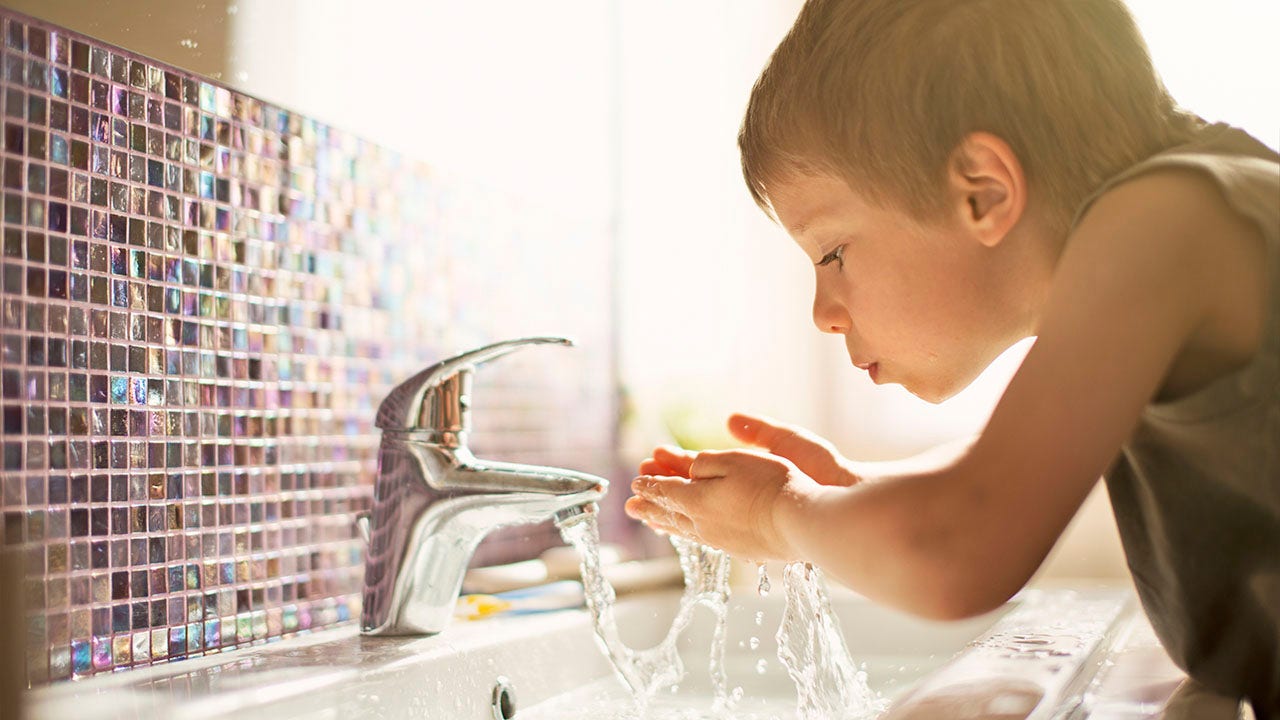Health
How to Light Charcoal Without Lighter Fluid — BBQ Pros’ Genius Tricks Make It Easy

Cooking over charcoal undoubtedly gives food an irresistible smokey, charred flavor. Plus, charcoal grills tend to be more affordable than other options, making them a budget-friendly choice for backyard cooking. Trying to get the coals lit however — especially if you are out of lighter fluid — could take forever (we’ve been there!). So we asked BBQ experts just how to light charcoal without lighter fluid, and thankfully, they gave us plenty of options so you can still enjoy the smoky flavor on your food in a flash.
Why do you need lighter fluid to light charcoal?
Charcoal needs an initial spark to catch fire. That’s where lighter fluid comes in handy. It’s a flammable liquid that helps kickstart the charcoal ignition process. When you pour a bit of lighter fluid on the charcoal and then apply a flame, say from a match or a lighter, it ignites quickly. The fluid’s volatile nature helps create a consistent and steady flame, making it much easier to get your charcoal burning for that perfect grilling experience.
If you attempt to light charcoal without using lighter fluid or some other form of accelerant, it could result in a longer wait time and more effort to achieve the desired temperature for cooking. Using lighter fluid or alternative methods helps ensure a smoother and quicker lighting process.
One caveat, says Emma Parker, cooking expert and co-founder of TheTroutFish.com: “No matter what method you choose, remember to prioritize safety throughout the lighting process. This includes always wearing heat-resistant gloves, using long tongs when handling hot charcoal and avoiding using gasoline or other highly flammable liquids to start the fire, as they can lead to dangerous flare-ups.”
How to light charcoal without lighter fluid
Have newspaper? Try the pyramid method
When you don’t have lighter fluid on hand, simply being mindful of the way you place your charcoal briquettes can help make lighting them a cinch. “This traditional method involves arranging charcoal in a pyramid shape to facilitate ignition,” says Parker.
Her how-to: Place a few pieces of crumpled newspaper in the center of the grill and stack the charcoal in a pyramid shape on top of it. Light the newspaper in several places, this will help to ignite the charcoal. Once the charcoal is burning and covered with a layer of white ash, use long-handled tongs to spread it out evenly before placing the grill grate on top.
The pyramid trick allows the heat from the bottom coals to rise up, and since the charcoal is close together, it disperses the heat from one briquette to the next.
Another way to use newspaper to light charcoal with no lighter fluid: “Putting a touch of cooking oil on the crumpled newspapers can be a great lighter fluid alternative,” shares JL Surjan, who writes about BBQ at JLSurjan.com. “It’s like recycling with a BBQ twist!”
Simply drizzle the oil onto some sheets of balled up newspaper, tuck them down into the coals and light. The flammable oil will help ignite the charcoal.
Have an empty egg carton? Set the charcoal inside
“Place an empty egg carton inside the grill, put your charcoal in the egg compartments, then light the carton,” says Sarah Clemence, founder of BusyBloomingJoy.com. “It’ll burn at just the right speed to light the briquettes so you can start cooking — no lighter fluid required.”
Have tree twigs? Make a small nest
Whether you’re cooking in your backyard or on a camping trip, natural fire starters can still get the job done! Dry twigs, leaves and coconut husks are all great options.
“Create a small nest of natural fire starter materials in the center of the charcoal pile,” explains Parker. “Stack charcoal around the nest, leaving space for air circulation. Light the fire starter materials and wait for the charcoal to catch fire and ash over. Once ready, spread the charcoal evenly and start grilling.”
For a chemical-free way to light charcoal: Try a charcoal chimney

An affordable tool that can make it a breeze to light charcoal without lighter fluid? A charcoal chimney (Buy from Amazon, $14.98). These handy metal tubes feature a grate inside to allow for more airflow.
“It’s the fastest and cleanest way to light your charcoal grill quickly,” says Kita Roberts of food blog GirlCarnivore.com.
To do: Add an all-natural fire starter like crumpled newspaper to the bottom of the chimney, then fill with charcoal on top. Light your fire starter through the holes at the bottom of the tube. In 10-15 minutes when the charcoal is ashed over the top, carefully add it to your grill and you’re ready to go!
“We love this method because there are no chemicals involved, and you get the best grilled flavor on whatever you’re cooking,” adds Roberts.
Another form of kindling you can use instead of newspaper? Tumbleweeds, which you can get at your local supermarket, says chef Mallorey Atkins of the catering company the Farm to Belly. Simply put them at the bottom of your charcoal chimney or before forming your charcoal pyramid. Since they’re made of wood and paraffin wax, they’ll help the coals catch once lit.
To see some these (and more) tricks in action, check out the below video on how to light your charcoal without lighter fluid:
For great grilling recipes to try once your charcoal is lit, keep reading!
Grilled Pineapple Is That Thing You Think You Won’t Like — Then You Try It And Fall In Love
Royal Chef Reveals How to Grill Up a ‘Perfect Burger’ Fit for a Queen
Brushing Burgers With This Condiment While They Cook Will Make Them Juicier and More Flavorful
Woman’s World aims to feature only the best products and services. We update when possible, but deals expire and prices can change. If you buy something via one of our links, we may earn a commission.
Questions? Reach us at shop@womansworld.com

Health
Kennedy’s Plan for the Drug Crisis: A Network of ‘Healing Farms’

Though Mr. Kennedy’s embrace of recovery farms may be novel, the concept stretches back almost a century. In 1935, the government opened the United States Narcotic Farm in Lexington, Ky., to research and treat addiction. Over the years, residents included Chet Baker and William S. Burroughs (who portrayed the institution in his novel, “Junkie: Confessions of an Unredeemed Drug Addict”). The program had high relapse rates and was tainted by drug experiments on human subjects. By 1975, as local treatment centers began to proliferate around the country, the program closed.
In America, therapeutic communities for addiction treatment became popular in the 1960s and ’70s. Some, like Synanon, became notorious for cultlike, abusive environments. There are now perhaps 3,000 worldwide, researchers estimate, including one that Mr. Kennedy has also praised — San Patrignano, an Italian program whose centerpiece is a highly regarded bakery, staffed by residents.
“If we do go down the road of large government-funded therapeutic communities, I’d want to see some oversight to ensure they live up to modern standards,” said Dr. Sabet, who is now president of the Foundation for Drug Policy Solutions. “We should get rid of the false dichotomy, too, between these approaches and medications, since we know they can work together for some people.”
Should Mr. Kennedy be confirmed, his authority to establish healing farms would be uncertain. Building federal treatment farms in “depressed rural areas,” as he said in his documentary, presumably on public land, would hit political and legal roadblocks. Fully legalizing and taxing cannabis to pay for the farms would require congressional action.
In the concluding moments of the documentary, Mr. Kennedy invoked Carl Jung, the Swiss psychiatrist whose views on spirituality influenced Alcoholics Anonymous. Dr. Jung, he said, felt that “people who believed in God got better faster and that their recovery was more durable and enduring than people who didn’t.”
Health
Children exposed to higher fluoride levels found to have lower IQs, study reveals

The debate about the benefits and risks of fluoride is ongoing, as RFK Jr. — incoming President Trump’s pick for HHS secretary — pushes to remove it from the U.S. water supply.
“Fluoride is an industrial waste associated with arthritis, bone fractures, bone cancer, IQ loss, neurodevelopmental disorders and thyroid disease,” RFK wrote in a post on X in November.
A new study published in JAMA Pediatrics on Jan. 6 found another correlation between fluoride exposure and children’s IQs.
RFK JR. CALLS FOR REMOVAL OF FLUORIDE FROM DRINKING WATER, SPARKING DEBATE
Study co-author Kyla Taylor, PhD, who is based in North Carolina, noted that fluoridated water has been used “for decades” to reduce dental cavities and improve oral health.
Fluoride exposure has been linked to a variety of negative health effects, yet benefits oral health. (iStock)
“However, there is concern that pregnant women and children are getting fluoride from many sources, including drinking water, water-added foods and beverages, teas, toothpaste, floss and mouthwash, and that their total fluoride exposure is too high and may affect fetal, infant and child neurodevelopment,” she told Fox News Digital.
The new research, led by scientists at the National Institute of Environmental Health Sciences (NIEHS), analyzed 74 epidemiological studies on children’s IQ and fluoride exposure.
FEDERAL JUDGE ORDERS EPA FURTHER REGULATE FLUORIDE IN DRINKING WATER DUE TO CONCERNS OVER LOWERED IQ IN KIDS
The studies measured fluoride in drinking water and urine across 10 countries, including Canada, China, Denmark, India, Iran, Mexico, Pakistan, New Zealand, Spain and Taiwan. (None were conducted in the U.S.)
The meta-analysis found a “statistically significant association” between higher fluoride exposure and lower children’s IQ scores, according to Taylor.
“[It showed] that the more fluoride a child is exposed to, the more likely that child’s IQ will be lower than if they were not exposed,” she said.

Scientists found a “statistically significant association” between higher fluoride exposure and lower children’s IQ scores. (iStock)
These results were consistent with six previous meta-analyses, all of which reported the same “statistically significant inverse associations” between fluoride exposure and children’s IQs, Taylor emphasized.
The research found that for every 1mg/L increase in urinary fluoride, there was a 1.63-point decrease in IQ.
‘Safe’ exposure levels
The World Health Organization (WHO) has established 1.5mg/L as the “upper safe limit” of fluoride in drinking water.
“There is concern that pregnant women and children are getting fluoride from many sources.”
Meanwhile, the U.S. Public Health Service recommends a fluoride concentration of 0.7 mg/L in drinking water.
“There was not enough data to determine if 0.7 mg/L of fluoride exposure in drinking water affected children’s IQs,” Taylor noted.
FDA BANS RED FOOD DYE DUE TO POTENTIAL CANCER RISK
Higher levels of the chemical can be found in wells and community water serving nearly three million people in the U.S., the researcher noted.
She encouraged pregnant women and parents of small children to be mindful of their total fluoride intake.

Nearly three million people have access to wells and community water with fluoride levels above the levels suggested by the World Health Organization. (iStock)
“If their water is fluoridated, they may wish to replace tap water with low-fluoride bottled water, like purified water, and limit exposure from other sources, such as dental products or black tea,” she said.
“Parents can use low-fluoride bottled water to mix with powdered infant formula and limit use of fluoridated toothpaste by young children.”
For more Health articles, visit www.foxnews.com/health.
While the research did not intend to address broader public health implications of water fluoridation in the U.S., Taylor suggested that the findings could help inform future research into the impact of fluoride on children’s health.
Dental health expert shares cautions
In response to this study and other previous research, Dr. Ellie Phillips, DDS, an oral health educator based in Austin, Texas, told Fox News Digital that she does not support water fluoridation.

The study researcher encouraged parents of small children to be mindful of their total fluoride intake. (iStock)
“I join those who vehemently oppose public water fluoridation, and I question why our water supplies are still fluoridated in the 21st century,” she wrote in an email.
“There are non-fluoridated cities and countries where the public enjoy high levels of oral health, which in some cases appear better than those that are fluoridated.”
CLICK HERE TO SIGN UP FOR OUR HEALTH NEWSLETTER
Phillips called the fluoride debate “confusing” even among dentists, as the American Dental Association (ADA) advocates for fluoride use for cavity prevention through water fluoridation, toothpaste and mouthwash — “sometimes in high concentrations.”

Fluoride is used in water, toothpaste and mouthwash to help prevent cavities. (iStock)
“[But] biologic (holistic) dentists generally encourage their patients to fear fluoride and avoid its use entirely, even if their teeth are ravaged by tooth decay,” she said.
“Topical fluoride is beneficial, while systemic consumption poses risks.”
Phillips encouraged the public to consider varying fluoride compounds, the effect of different concentrations and the “extreme difference” between applying fluoride topically and ingesting it.
“Topical fluoride is beneficial, while systemic consumption poses risks,” she cautioned.
“Individuals must take charge of their own oral health using natural and informed strategies.”
The study received funding from the National Institute of Environmental Health Sciences (NIEHS), the National Institutes of Health (NIH) and the Intramural Research Program.
Health
Treating Other Diseases With Ozempic? Experts Weigh In | Woman's World

Sign Up
Create a free account to access exclusive content, play games, solve puzzles, test your pop-culture knowledge and receive special offers.
Already have an account? Login
Use left and right arrow keys to navigate between menu items.
Use escape to exit the menu.
-
/cdn.vox-cdn.com/uploads/chorus_asset/file/25822586/STK169_ZUCKERBERG_MAGA_STKS491_CVIRGINIA_A.jpg)
/cdn.vox-cdn.com/uploads/chorus_asset/file/25822586/STK169_ZUCKERBERG_MAGA_STKS491_CVIRGINIA_A.jpg) Technology1 week ago
Technology1 week agoMeta is highlighting a splintering global approach to online speech
-

 Science7 days ago
Science7 days agoMetro will offer free rides in L.A. through Sunday due to fires
-
/cdn.vox-cdn.com/uploads/chorus_asset/file/23935558/acastro_STK103__01.jpg)
/cdn.vox-cdn.com/uploads/chorus_asset/file/23935558/acastro_STK103__01.jpg) Technology7 days ago
Technology7 days agoAmazon Prime will shut down its clothing try-on program
-

 News1 week ago
News1 week agoMapping the Damage From the Palisades Fire
-

 News1 week ago
News1 week agoMourners Defy Subfreezing Temperatures to Honor Jimmy Carter at the Capitol
-
/cdn.vox-cdn.com/uploads/chorus_asset/file/25826211/lorealcellbioprint.jpg)
/cdn.vox-cdn.com/uploads/chorus_asset/file/25826211/lorealcellbioprint.jpg) Technology6 days ago
Technology6 days agoL’Oréal’s new skincare gadget told me I should try retinol
-
/cdn.vox-cdn.com/uploads/chorus_asset/file/25832751/2192581677.jpg)
/cdn.vox-cdn.com/uploads/chorus_asset/file/25832751/2192581677.jpg) Technology3 days ago
Technology3 days agoSuper Bowl LIX will stream for free on Tubi
-

 Business4 days ago
Business4 days agoWhy TikTok Users Are Downloading ‘Red Note,’ the Chinese App















